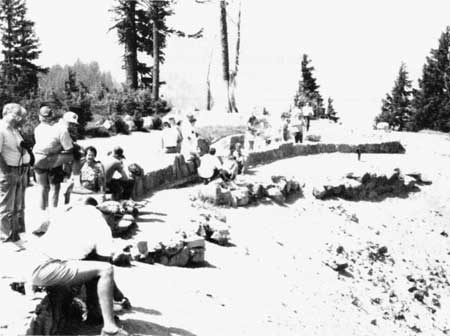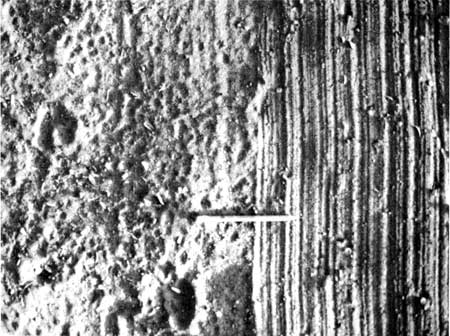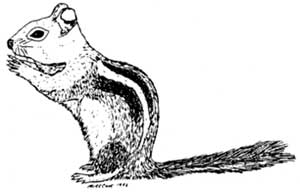Ground Squirrel Activity at Rim Village
Sixty Years of High Density Squirrel Populations
The feeding of ground squirrels by visitors in the Rim Village area probably began before the Crater Lake Lodge was constructed in 1909, at a time when camping was allowed anywhere along the rim. In all probability, this further increased after 1928, when the parking lot and cafeteria at Rim Village were constructed in their present locations and the Crater Wall trail was opened (the latter served as the access to the lake until 1959 and is now closed; its trailhead was along the promenade in front of the cafeteria). By the late 1930s, squirrel populations were high at Rim Village and were mentioned by Kenneth Gordon in his The Natural History and Behavior of the Western Chipmunk and Mantled Ground Squirrel, published in 1943. Obviously impressed with the unusual density of ground squirrels at Rim Village, he wrote “…a peanut concession at one of these points should net a tidy sum…”.

Feeding Ground Squirrels
Visitors and ground squirrels meet at the historic location of the Crater Wall trail.
Dr. Gordon’s impression of the squirrel populations at Rim Village may have been based on research he conducted on golden mantled ground squirrel populations in several campgrounds located in Washington State. He concluded in those studies that a population density of five squirrels per acre was well above the population density found under natural conditions. This can be put into perspective by the figure cited in a 1947 paper by Orthello Wallis titled Mammals of Crater Lake National Park. Wallis wrote “…in 1938, there were 150 squirrels, by actual count of marked specimens, between the lodge and the head of the lake [Crater Wall] trail.” Since most of the squirrels live inside the caldera rim within 200 feet of the promenade, this area of roughly four acres provided habitat for approximately 37 squirrels per acre at that time. This figure is equivalent to a population density over seven times that of what Kenneth Gordon considered as “crowded”.
In 1951, seasonal naturalist Ralph Heustis conducted a ground squirrel study along the promenade between the Crater Wall trail and the lodge. His study area was equivalent to that of 1938. Dr. Huestis captured and marked 79 squirrels, a population density considerably less than that found 13 years earlier. Nevertheless, his count showed a density of almost 20 ground squirrels per acre in the Rim Village area. This is easily four to five times larger then whet Gordon expected under natural conditions. Heustis also stated that the greatest density of ground squirrels in the study area was located at the head of the Crater Wall Trail. He noted that a dozen squirrels could often be found there begging for food.
In 1984, S. Kent Schwarzkopf conducted a study on The Feeding of Golden Mantled Ground Squirrels at Crater Lake National Park. The study site was located at the head to the Crater Wall Trail, probably because this was still the location of the highest squirrel activity in the area. I personally spent time counting squirrels at this same location, a place that present park staff call ” Squirrel Row” due to the obviously pronounced activity of squirrels in this area. Periods of observation varied, but at all times of the day I could easily count eight to twelve squirrels and once counted fifteen. In light of past studies and the observations I made, it is fair conclude that large numbers of squirrels have been present at this site for 60 years at a minimum.
Nocturnal Activity Along the Promenade
Gordon observed that “…Ground Squirrels typically accept as much food as possible from visitors, run a short distance to a location where they dig a hole and bury the contents of their pouches before quickly returning for more handouts”. During my surveys, I have noticed that squirrels at the rim in 1992 were no different than those observed in the late 1930s. Most of the food that is accepted from visitors is taken into the caldera, usually about 50 to 60 feet from the promenade, and buried. These squirrels quickly return for more handouts. Their instinct to gather and store food makes golden mantled ground squirrels surprisingly efficient in cleaning up the handouts given to them along the promenade. On several occasions I looked for food scraps in the vicinity of ” Squirrel Row” at the end of a busy day and found that even the crumbs were absent.
Considering the generous handouts that are provided to these rodents by visitors to the park, it would be interesting to determine how many pounds of food is cached each day by these squirrels. Whatever the amount may be, there is no doubt that a substantial quantity of food is moved from the promenade to shallow storage sites inside the caldera. Although these caches may seem secure to the squirrels, shallow hiding places are hardly safe from the prying noses of nocturnal residents like mice and woodrats. As a result, ground squirrels are unintentional conduits of food for a host of other animals in the Rim Village area. It would not be surprising/hat ground squirrel activity during the day is matched by an equal amount of activity at night by nocturnal animals.
The feeding of ground squirrels probably impacts nocturnal rodents who feed on their food caches. In an attempt to estimate the population density of nocturnal rodents, the soil along the prominade wall was swept (right side of picture) at about 9:00 pm. At 6:00 am the next day, the swept area was heavily trampled by nocturnal rodents (left side of picture). (Note: broom marks in the picture were made at 6:00 am for contrast needed in the photo.)
In an attempt to assess the level of nocturnal activity and the associated population densities of animals in the Rim Village area, I went there one evening around nine and used a broom to gently smooth down the dirt at “Squirrel Row”. At roughly six o’clock the next morning, I returned to see what had happened. The area I swept was heavily trampled by small rodents like mice and wood rats. Deer tracks were also noted as were some tracks of ravens that I scared away when I arrived. The total number of individual rodents that had been active here during the night was not something that I could determine but I could easily say that activity was intense. The level of activity along the promenade was surprising, especially in light of the efficiency with which ground squirrels gather every scrap that they can find and transport it to cache sites inside the caldera. If the nocturnal activity along the promenade was as pronounced as it was with only a few morsels of food available and a poor selection of shelter, I could only imagine what activity must be like 50 to 60 feet below the rim where squirrel caches abounded and shelter is abundant! It seems reasonable to speculate that nocturnal rodent activity must easily match, if not exceed, the activity of the ground squirrels that people feed on days during the summer.
Accumulations of Animal Feces
The high density of rodents in the Rim Village area means that there is also an appreciable amount of rodent excrement being deposited there, too. I trapped several squirrels and collected the feces that was excreted during the active period of their day. All these samples were dried and weighed on a triple beam balance that was accurate to a hundredth of a gram. I found that the average weight of a squirrels daily excrement (excluding urine) was about 1.5 grams (dry weight). Assuming that golden mantled ground squirrels are active for five months out of the year (May to September) and estimating that there are about 20 squirrels per acre in the Rim Village area, then the calculation of 4. 5 kilograms ( 10 pounds) per acre is a reasonable approximation for the accumulation of their body waste over one summer season. This means that over the past 60 years or more of historically high ground squirrel population densities in Rim Village, at least 270 kilograms (600 pounds) of feces per acre has been produced there by ground squirrels alone. Much of this 600 pounds was probably deposited inside the caldera wall. If one adds in the waste products deposited by enhanced populations of birds, mice, rats and deer that feed on squirrel caches and if this includes the waste deposits contributed by an assortment of predators that feed on the dense populations of rodents, the total fecal deposit in the Rim Village area over the past 60 years is probably close to or more than 900 kilograms (one ton) per acre.



